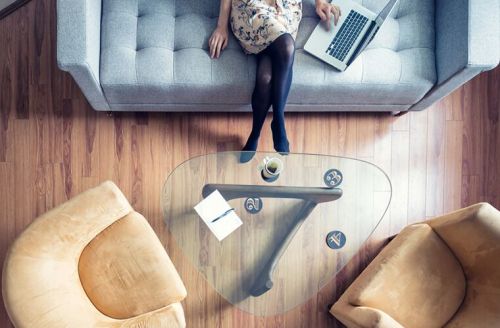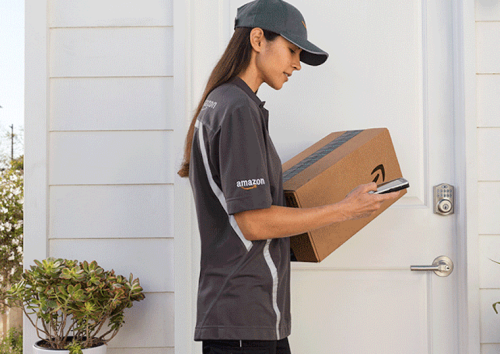Our editors independently select these products. Making a purchase through our links may earn Well+Good a commission
6 ways your smart home can make you healthier
From the garage to the kitchen to the bedroom, smart tech in your home can improve your health.

Gadgets and gizmos may not be the first things that spring to mind when you hear the phrase “healthy home”—screens (and the blue light that comes with them) are much more likely to be vilified for the harm they can do to your mental and physical health. But, according to digital lifestyle expert Carley Knobloch, that doesn’t have to be the case. Instead, “technology should rise up to serve you, not bum you out,” she writes on her website.
“And the truth is, smart homes are no longer for the super wealthy anymore—they’re decidedly mainstream,” Knoblock says. From deeper sleep to stronger security, more serenity to a healthier diet—she offers six ways that embracing tech at home can better your health.
Keep reading to learn how you can outfit your smart home to improve your health.

1. Smarter deliveries
You want to try a healthy meal kit or renew your vitamin order or try out a sound machine, but don’t trust a delivery to sit on your porch all afternoon? Introducing smart garage door openers. “When I talk about smart homes, people think I’m going to talk about virtual reality headsets,” says Knobloch. “But the ability to open and close the garage door from your smartphone is huge!” With a smart garage door opener (which you can buy from retailers like Amazon, Best Buy, and Home Depot) you can grant anyone access from afar.
Amazon Key also coordinates with the Cloud Cam and a smart lock to allow couriers to leave packages for Prime members inside your front door. This means your healthy-lifestyle deliveries are safely out of sight (and out of the rain or sleet or snow)—without you taking a major security risk, like leaving a key under the mat.
2. Smarter sleep
“There’s so much research on how humidity impacts everything from sleep to asthma,” says Knobloch. But for a humidifier to actually work, you’ve got to remember to turn it on—or buy a smart sensor to do that for you. “There are a number of smart humidifiers on the market that will monitor the air, and automatically spring into action when humidity levels need adjustment.” Some examples: Molekule (which features a sleek design and a handle so you can carry it from room to room), Dyson, and LG.
3. Smarter cooking
From dimming lights to playing music, the list is long of what voice-controlled assistants, like Amazon’s Echo (AKA Alexa) and Google Home, can do around the house. But voice activation can be especially helpful in the kitchen, when your fingers are covered in flour or garlic and you want to look up the answer to a cooking question without touching your phone. They also make it breezy to add items to your grocery list, so meal planning is easier (as is your follow-through to cook more and order take-out less). “The inspiration and instruction in the kitchen, with recipes and how-to’s, is really engaging,” she says.
Connected appliances, like those from LG, also allow you to monitor your kitchen and oven remotely—meaning you can make sure your roast is roasting (and not burning) from the next room, or double-check that you have all the kale you need for the night’s meal while you’re still at the store.
4. Smarter protection
Most people have a love-hate relationship with their smoke and carbon monoxide detectors: They love that the devices help keep them safe, but hate that they’re so hard to test and always seem to need new batteries in the middle of the night. “Most people have no confidence that they work—until they chirp in the middle of the night,” says Knobloch. But the Nest Protect seems to solve many of those annoyances (including being able to disarm it from your phone), while delivering major peace of mind. “When an alarm is triggered, a human voice calls out that there’s a fire, which is more likely to wake heavy sleepers,” she says.
Smart tech can also protect your home from the outside. Samsung partnered with ADT, for example, to create a security system you can arm and disarm via your app. (So you know your home is safe while you’re downward-dogging in Bali.)
5. Smarter music
Sure, you can play a song right from your smartphone, but we doubt you’re going to throw an impromptu dance party off your cell. But with a smart audio system, you can sync your phone to in-house speakers that pump out quality tunes at a volume that makes you want to actually move. “A whole-home audio system used to be really expensive and take a ton of time and planning, and then along came Sonos,” says Knobloch. The home sound system is a snap to set up, and you can easily move it around, if you want to host an outdoor BBQ or move apartments. And having easy, always-on access to music isn’t just about breaking a sweat, points out Knobloch—the right tunes can also lift your mood or help calm you down when you’re in a stress spiral.
6. Smarter sweat
If you’re lucky enough to have home exercise equipment, we’re betting that you tend to sweat while zoned out in front of the TV or listening to your earbuds. And those ho-hum home workouts are probably a far cry from the calorie torching that happens when you make it to a spin class. But, thanks to the smart home movement, there’s a way to bring that high-energy workout to your house: “I’ve been lusting after the Peloton bike,” says Knobloch. “It’s basically a spin bike with a huge tablet screen that allows you to tap into live spin classes or recorded class, from your home.” Flywheel also just rolled out its own version.
Peloton and Flywheel are just the beginning: Boutique fitness is going digital. As is the bedroom, so you can get fully optimized zzz’s.
Sign up for the Well+Good SHOP Newsletter
Get exclusive deals on wellness, beauty, fitness, and food products that have been hand-picked by our editors.
Got it, you've been added to our email list.









